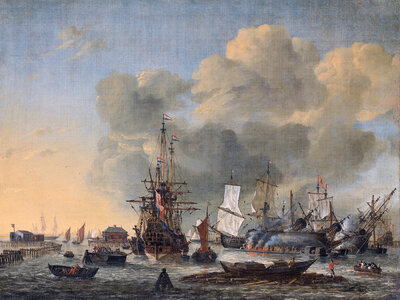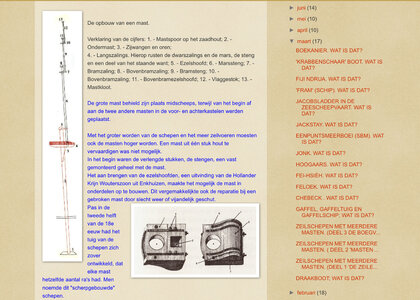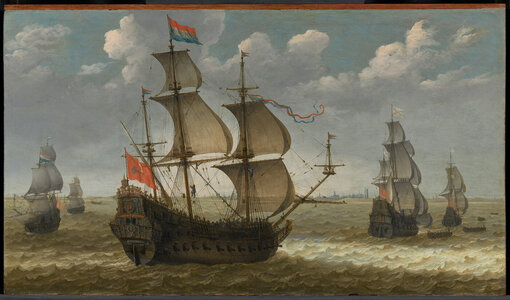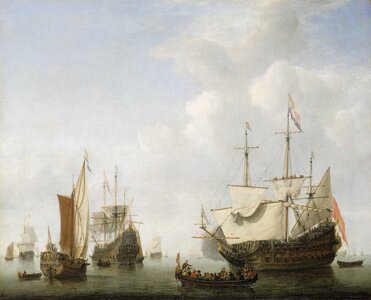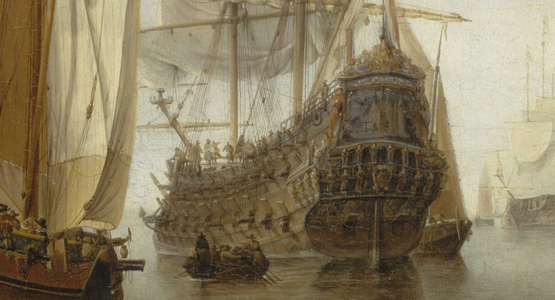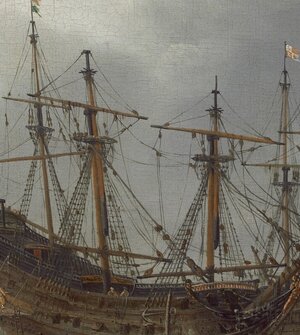AMSTERDAM HARBOR SCENE c. 1654/1655, Oil on Canvas
View attachment 265644
Reinier Nooms, called Zeeman, National Gallery of Art, Washington, The Lee and Juliet Folger Fund, 2011.3.1
Inherent to our shipbuilding is the research process in which we find out as much as we can about the subject of our choice. Armed with information gathered from a multitude of books and Monographs, we embark on our collective mission of building the most historically accurate ships. Not often though can a painting be regarded as a definitive source of information (there are notable exceptions of course - the Van de Veldes, Petts etc.), so I was particularly pleased to find this brilliant analysis by Henriette Rahusen of the NGA in Washington. The fact that the information is classified as "Open Access" makes it all the more commendable.
Overview
Reinier Nooms, was an Amsterdam painter and graphic artist also known as Reinier Zeeman (which means seaman), who specialized in maritime subjects. His career coincided with the heyday of Dutch commercial and maritime power in the 17th century, and Amsterdam’s bustling harbor in the IJ estuary provided Nooms with much of his artistic inspiration.
This painting celebrates a powerful Amsterdam family and its link to an important warship owned by the city’s Admiralty. The castle depicted on the ship’s tafferel (the painted panel on the stern) identifies it as the
HUIS TE SWIETEN, which was built in 1653 and captured by the English in 1665.
The warship served as the flagship of Michiel de Ruyter, one of Holland’s greatest naval heroes, on three expeditions in the 1650s. The artist signed the painting as "R. Zeeman" upon its completion around 1658, embedding his coined name on the flag on the warship’s main mast. Coincidentally, Nooms accompanied De Ruyter on an expedition to the Mediterranean from 1661 to 1663.
The Huis te Swieten was named after the country estate of burgomaster Cornelis Bicker (1592–1654), a wealthy merchant and a member of the most powerful family in Amsterdam in the 1650s.
ANALYSIS
Amsterdam Harbor Scene is a beautiful example of Reinier Nooms’s skill in combining first-hand knowledge of maritime life with artistic excellence, enabling him to create highly realistic depictions of not only the ships and the myriad activities enlivening this busy port, but also the changing atmospheric character of the sky and water.[1]
Amsterdammers were justifiably proud of their city and its harbor—the source of the city’s prosperity. Then, as now, visitors were taken on boat tours of the bustling port; and the crest of Amsterdam on the canopied sloop in the foreground of this painting indicates that its well-dressed passengers were guests of the municipal government.[2]
View attachment 265645
The city crest denotes municipal ownership, so the people in the larger sloop are likely dignitaries treated to a harbor tour. Billowing clouds, fluttering flags, and slightly choppy water all add to the immediacy of the visual experience.
The distinctive line of wooden breakers that delineates the harbor proper, with openings at regular intervals to allow ships to enter and exit, identifies this scene as Amsterdam’s harbor in the IJ estuary.
View attachment 265646
View attachment 265647
Each opening was barricaded at night by a guard who placed a floating tree trunk (boom) or chain across it; correspondingly, the guard sheds flanking each opening were called boomhuisjes.[2]
View attachment 265648
On the far left, two warships, their gun ports open to air out the decks, are moored along the outside of the breakers.
View attachment 265649
Two men standing in front of a boomhuisje observe the departure of a small sailing sloop toward the broad waters of the IJ.[4]
View attachment 265650
Inside the harbor are oceangoing vessels, including a warship and three merchant ships, undergoing maintenance and repairs. To the left of center, two men on a temporary platform suspended from a railing are using fibers and pitch to caulk the hull of a large three-master.
View attachment 265651
A workman on the large raft below (A) tends to the vat of hot pitch suspended above a fire. A couple of small boats are tied to the raft: a man in a blue jacket (B) seems to lower a fish trap into the water, while two women (C) lean over the side of their skiff to do laundry in the waters of the IJ.
Nooms’s careful depiction of the rigging on these ships epitomizes his expert eye for nautical details. For example, he carefully records the complex system of masts on each ship. Square-rigged sailing vessels generally had three masts (spars) consisting of at least a lower mast and a topmast, but larger ships required a third section, the topgallant mast. In port (or in stormy weather), an upper spar could be struck so that its yard rested on the cap of the mast below it, after which the spar was lashed to the lower section, as is the case with the three-master that is being caulked.[3]
View attachment 265652
Lashed spars are even more visible on the careened ship in Nooms’s Caulking Ships at the Bothuisje on the Y at Amsterdam [FIG. 1], while the jumble of masts, spars, and rigging inspire awe for the expertise of Holland’s mariners.
View attachment 265653

ed behind the three-masted merchantman (A) in Amsterdam Harbor Scene, is a Fluyt (B) bearing small white-and-red flags. With maximum cargo space and minimal crew requirements, the fluyt was the workhorse of the Dutch Republic’s renowned commercial fleet. Unfortunately, the decoration of the stern is not sufficiently clear to positively identify the ship. The vessel in the center background (C) has been careened (hauled onto its side) in order to expose the hull so that it can be caulked below its waterline. The open water of the IJ beyond the breakers is dotted with other ships.
View attachment 265658
Nooms enlivened the blue-gray tonality of the overall scene with a sensitive use of light and restrained use of brighter colors, preserving an overall clarity of form while subtly drawing the eye to the warship that is moored in the sunlit section of the harbor at the right.
View attachment 265659
The flag on the main mast of the warship bears the artist’s signature (in gold): “R. Zeeman,” the nickname meaning “sailor” with which Nooms signed his paintings.
View attachment 265660
Touches of gold give the decorations on the ship’s stern a wonderful three-dimensionality, while delicate white highlights animate the numerous figures and activate the undulating surface of the water.
View attachment 265661
The remarkable triangular cloud formation that seems to rise up from the horizon is likely zeevlam (sea flame), a fog bank that develops very suddenly above coastal waters, in this case the waters of the Zuiderzee, the inland sea just northeast of Amsterdam. The phenomenon tends to occur on balmy days in late spring or early summer, when much warmer air hits seawater that is still relatively cold. [4]
This harbor scene was in all likelihood commissioned by a member of the powerful Amsterdam regent family Bicker. The image of a castle on the warship’s tafferel (or taffrail, the painted panel on the stern) identifies the ship as the Huis te Swieten, an important warship in the fleet of the city’s Admiralty.
View attachment 265662
Detail, the stern of warship Huis te Swieten
The warship was named after Castle Swieten (or Zwieten), since 1632 the country estate of Cornelis Bicker (1592–1654).
View attachment 265662View attachment 265663
Cornelis Bicker
In 1646, the artist Roelant Roghman (Dutch, 1627 - 1692) made four drawings of the castle for his large series on castles and country estates in the provinces Holland and Utrecht. One of these four drawings was almost certainly the model for the warship’s tafferel.
View attachment 265664
Roelant Roghman, Schloss Swieten
The Huis te Swieten (sometimes Huys te Zwieten) was an impressive warship with a fascinating history. The Admiralty of the Italian port city of Genoa had commissioned the vessel from the shipyard of the Amsterdam Admiralty. However, following the ship’s launch in 1653, it was not delivered to the Genoese. At that time the Dutch Republic was embroiled in the First Anglo-Dutch War (1652–1654), so Amsterdam’s Admiralty requisitioned the state-of-the-art vessel for its own fleet.
The 786-ton ship was armed with four cannons that shot 24-pound balls, 22 x 18-pounders, 20 x 8-pounders, and 14 x 4-pounders; its crew at the time consisted of 106 seamen and 80 marines. The warship had a draught of 15 feet. In battle against the English in 1665, about 300 marines were crammed aboard. In 1653, the Amsterdam Admiralty requisitioned a second ship commissioned by the Genoese; christened Huis te Kruiningen, it was nicknamed “the Small Genoan” in contrast to Huis te Swieten, which was known as “the Great Genoan”.
Soon after the vessel’s launch, the celebrated marine painter Willem van de Velde the Elder (Dutch, 1611 - 1693) included the Huis te Swieten in a series of drawings depicting naval ships participating in that war.
View attachment 265666
Willem van de Velde the Elder, Huis te Swieten, 1653, black chalk, present location unknown [8]
In Van de Velde’s drawing, Castle Swieten on the tafferel is clearly identifiable. The drawing was at Sotheby’s, London, December 10, 1968, lot 59. Gratitude is expressed to Gregory Rubenstein, Sotheby’s London, who graciously provided this reference and the 1968 catalog image.
View attachment 265667
The 'Huis te Zwieten' and other ships becalmed - Willem van de Velde the Elder
In the left foreground, a port-bow view of the 'Huis te Zwieten' ('House/Castle Sweeten') with topsails loosed, buntlines of the courses hauled up and a flag at the main. There are other ships in the background. [9]
The Admiralty of Amsterdam owned the warship from its launch in 1653 until 1661, when it was sold to the Amsterdam chamber of the Dutch East India Company (known by its acronym VOC). Under the ownership of the VOC, the ship departed for Ceylon (Sri Lanka) on April 11, 1661. As part of the VOC fleet, the Huis te Swieten provided convoy protection to the company’s large cargo ships during the risky return voyage from Asia, when they were loaded to the brim with precious goods. [12]
View attachment 265668
The crossed anchors to the right of the rudder (A) denote the Admiralty, while Amsterdam’s city crest (three vertical crosses) (B) can be seen above the rudder. Given the presence of the Admiralty crest and the absence of the initials of the VOC, Nooms must have painted this work prior to 1661.
At the outbreak of the Second Anglo-Dutch War (1664–1666), the VOC lent the Huis te Swieten back to the fleet of the Dutch Republic. In September 1665, at the height of the war, the English Navy captured the ship in battle, after which it was incorporated into the English fleet as the House of Swedes. Fox calls Huis te Swieten the best ship captured by the English in the Second Anglo Dutch War. In 1667 the warship came to an ignominious end when the English scuttled it at the mouth of the River Thames to prevent the Dutch fleet from sailing upriver. [13] & [14]
The Carved Figure of a Very Old Man Atop the Stern
View attachment 265669
This figure of a very old man atop the stern would seem to symbolize Neptune. However, it is rather unlikely that the sea god would be represented as an elderly man without a trident. A more likely explanation is that the stern figure actually depicts the greatest Genoese mariner of all time, the famous condottiere Admiral Andrea Doria (1466–1560). Not only had the municipal government of Genoa commissioned the ship, but it was actually known in the Dutch fleet by its nickname, “The Great Genoan.”
[15] Andrea Doria, despite his long career as a mercenary in the employ of King François I of France and Holy Roman Emperor Charles V, always gave precedence to the affairs of his home town. As “Liberator et Pater Patriae,” Doria refused the appointment to become Doge of Genoa, settling instead for the title “Censor for Life.” In this role he firmly ruled Genoa until his death at age 94. [15].
The model for the carved figure was probably Agnolo Bronzino’s famous portrait Andrea Doria as Neptune. [16]
View attachment 265670
Andrea Doria, however, is not the only admiral with a connection to the warship. Once commandeered into the fleet of Amsterdam’s Admiralty, the state-of-the-art Huis te Swieten served as the flagship of one of Holland’s greatest naval heroes, Michiel de Ruyter, when he led an armed convoy to the Mediterranean in 1653–1654. As Lieutenant Admiral of Holland and Westfriesland, De Ruyter captained the Huis te Swieten on several other missions, including an expedition to eradicate piracy along the coast of North Africa in 1661–1662. None other than Reinier Nooms accompanied Admiral de Ruyter on that voyage, and upon his return from the Mediterranean, Nooms painted four large canvases for the Admiralty depicting the port cities of Algiers, Tunis, Tripoli on the Barbary Coast, and Valetta on Malta. It is not certain, but it is very likely that the Admiralty of Amsterdam specifically recruited Nooms to create a visual record of the expedition.
It is highly probable that Amsterdam Harbor Scene was commissioned by Cornelis Bicker or one of his brothers. Throughout the second quarter of the 17th century the Bicker clan occupied the pinnacle of Amsterdam’s political and economic life. The four Bicker brothers—Andries (1586–1652), Jacob (1588–1647), Jan (1591–1653), and Cornelis—dominated Amsterdam’s municipal government to the extent that they, together with their inner circle, were known as the “Bickers’ League.” Building on the groundbreaking international ventures of their father, Gerrit Bicker (1554–1604), the commercial activities of the four brothers spanned the globe.[17]
In 1653, the year the Huis te Swieten was launched, Jan Bicker served as one of Amsterdam’s four burgomasters and Andries Bicker had just finished a term as Raad (commissioner) of the Admiralty. Cornelis Bicker was burgomaster in 1646, 1650, and 1654, and Andries held that post 10 times between 1627 and 1649. They were initiators, chief participants, and directors of various joint-stock companies, such as the Dutch East India Company, the Levant Company, the Dutch West India Company, and several others. The Bickers’ economic success led Holland’s most celebrated poet – Joost van den Vondel - to write the following ode in their praise:
How widely did the Bickers' banner
cast a shadow over the great ocean,
slicing through it with richly laden ships
that hauled the world’s golden harvest onto Holland’s bosom.
“Zoo wyt als Bickers vlagh den grooten Oceaen Beschaduwde, en doorsnee met ryck gelade schepen Die ’s weerelts gouden oegst in Hollants boezem slepen.” [18]
Each of the four brothers dedicated himself to trade with a distinct part of the world, a division of labor that in all likelihood was intentional. Cornelis Bicker—who purchased the castle and country estate Swieten in 1632—was one of the cofounders of the Dutch West India Company, which focused on trade with Africa and the Americas. Cornelis thrice served as burgomaster of Amsterdam, most importantly in 1650, the year that Prince Willem II of Orange overstepped his prerogatives as stadholder when he tried to enter the city by force.
Acting decisively, Cornelis and his brother Andries —a director of the Amsterdam chamber of the Dutch East India Company, a very wealthy trader with Russia, commissioner of the city’s Admiralty, and a 10-time burgomaster—ordered the defenses of Amsterdam to be readied for action. Faced with closed gates and primed cannons on the city walls, Prince Willem was forced to withdraw his troops; Amsterdam’s firm stance under Bicker leadership is considered a significant moment in Dutch republicanism.[18] & [19]
Cornelis and his country estate in Swieten are not the only connections between Nooms’s painting and the Bicker family. Cornelis’s brother Jan focused on trade with the Levant (the eastern part of the Mediterranean) and operated a thriving shipbuilding enterprise on a new man-made island off Amsterdam’s shoreline that he purchased in 1631, an island known ever since as Bicker’s Island.
Bicker’s Island is one of three islands that was developed in the waters of the IJ estuary as part of the city expansion of 1610. Reinier Nooms included a view of Bicker’s Island and the harbor of Amsterdam in his compilation of engravings Verscheijde Schepen en Gesichten van Amstelredam (Various Ships and Views of Amsterdam) published in 1654. [20]
View attachment 265671
Bicker’s shipyard personnel also would have taken care of the routine maintenance and repair of ships, as shown in the Gallery’s painting. Nooms’s engraving of Bicker’s Island includes a boomhuisje at the entrance of the harbor section known as the Nieuwe Waal, with Jan Bicker’s shipyard on the left. In Amsterdam Harbor Scene, another guardhouse farther out along the same row of breakers allows us to determine Nooms’s exact viewpoint: the northeastern shore of Bicker’s shipyard, looking across the IJ.
Reinier Nooms specialized in maritime subjects at the height of Dutch maritime, commercial, and artistic supremacy. Well-traveled and perhaps even a professional sailor, Nooms signed his works with his nickname “R. Zeeman” (sailor), often, as here, on a flag proudly fluttering from the top of a mast. Drawing on his intimate knowledge of ships and maritime life, Nooms created engravings and paintings that are so accurate that the settings, activities, and specific vessels can be identified. With its excellent condition, stunning light effects, and pleasing composition, Amsterdam Harbor Scene embodies the best of Nooms’s astute observations of daily life in this bustling port.
Henriette Rahusen
Sources:
[1] Literature on the career of Reinier Nooms is exceedingly sparse. For a brief discussion of his work, see Laurens J. Bol, Die holländische Marinemalerei des 17. Jahrhunderts (Braunschweig, 1973), 289–296. See also Jeroen Giltaij and Jan Kelch, Praise of Ships and the Sea: The Dutch Marine Painters of the 17th Century (Rotterdam and Berlin, 1997), 277.
[2] Old maps and profile views of Amsterdam clearly depict the breakers in the IJ estuary and the boomhuisjes. See, for example, Justus Danckert’s Profiel van Amsterdam of c. 1685. The artist Roelant Roghman also made a nice drawing of a boomhuisje in 1645. See Stadsarchief Amsterdam (Collectie van Eeghen), image no. 010055000046.
[3] John H. Harland, Seamanship in the Age of Sail (Annapolis, 1984), 20, 114, 117, and 119.
[4] For a description of zeevlam, see the website of the Dutch Royal Meteorological Institute,
http://www.knmi.nl/cms/content/36735/zeevlam, accessed December 9, 2011.
[5] National Gallery of Art, Washington, The Lee and Juliet Folger Fund, 2011.3.1
[6] Roelant Roghman, Schloss Swieten, 1646–1647, pen in brown and brush in gray, Graphische Sammlung Albertina, Vienna, inv. 15130
[7] See Abraham Rademaker, Kabinet van Nederlandsche en Kleefsche Outheden: Geteckent en in’t Koper gebragt door A. Rademaker (Amsterdam, 1725), fol. 95.
[8]
(
http://koti.mbnet.fi/felipe/Netherland/Netherland_ships_1648-1659/netherland_ships_1648-1659.html, accessed March 9, 2011).
[9] National Maritime Museum, Greenwich - Image reference: PY1730
[10] (National Maritime Museum, Greenwich).
[11] George S. Keyes, Mirror of Empire: Dutch Marine Art of the Seventeenth Century (Cambridge, 1990), 172–174. For Van de Velde the Younger’s canvas in the collection of the National Maritime Museum, Greenwich, see
http://collections.rmg.co.uk/collections/objects/12402.html, accessed February 4, 2011.
[12]
See
http://www.vocsite.nl/schepen/detail.html?id=11996, accessed December 9, 2011.
[13] Frank L. Fox, The Four Days’ Battle of 1666 (Andover, 2009), 113.
[14] See also J. J. Colledge, Ships of the Royal Navy: The Complete Record of All Fighting Ships of the Royal Navy, 4th ed., revised and updated by Ben Warlow (Philadelphia and Newberry, 2010), 188. Colledge lists the warship as House de Swyte. Close
[15]
See the biography of Andrea Doria,
http://www.britannica.com/biography/Andrea-Doria-Genoese-statesman
[16] Agnolo Bronzino, Rittrato di Andrea Doria in veste di Nettuno (Andrea Doria as Neptune), c. 1540–1550, oil on canvas, Pinacoteca di Brera, Milan. Scala / Art Resource, NY
[17] For biographical information on the Bicker family, see Johan Elias, De vroedschap van Amsterdam, 1578–1795, 2 vols. (Haarlem, 1903), 1:173–175.
[18] See Joost van den Vondel, De werken van Vondel, vol. 5 (1645–1656; reprint Amsterdam, 1931), 842, see
http://www.dbnl.org/tekst/vond001dewe05_01/, accessed March 3, 2011.
[19] Erlend de Groot, ‘A Touch of Exoticism: Foreign Coastal Scenes in Dutch Marine Painting’ in Turmoil and Tranquillity: The sea through the eyes of Dutch and Flemish masters, 1550–1700, Jenny Gaschke, ed. Greenwich, 2008, 33–36.
[20] Reinier Nooms, Bicker’s Eylandtengraving from Verscheyde Schepen en Gesichten van Amstelredam, Amsterdam, 1654, Rijksmuseum, Amsterdam, inv. RP-P-OB-20.527
I have taken the liberty of tagging a few members whom I think may find this is interesting. If I have omitted anyone, I apologize beforehand and if I have included someone who does not find this interesting, I also apologize.
Best regards - I hope you enjoy it.
@Uwek @Ab Hoving @Maarten @Kolderstok @Pathfinder65 @Canoe21 @DonRobinson @Peter Voogt @Henk Liebre @Steef66 @pingu57 @pietsan @janzwart @Hubac’s Historian @DARIVS ARCHITECTVS @dockattner @Vfordyce @Dean62 @Daniel20 @Dematosdg @Michiel de Ruyter @Ondras71 @RDN1954 @flying_dutchman2 @frankieg @Robertd @shota70 @Brewbrarian @Gennaro @PT-2 @Ptèr @GrantTyler @Alexander74





 ed behind the three-masted merchantman (A) in Amsterdam Harbor Scene, is a Fluyt (B) bearing small white-and-red flags. With maximum cargo space and minimal crew requirements, the fluyt was the workhorse of the Dutch Republic’s renowned commercial fleet. Unfortunately, the decoration of the stern is not sufficiently clear to positively identify the ship. The vessel in the center background (C) has been careened (hauled onto its side) in order to expose the hull so that it can be caulked below its waterline. The open water of the IJ beyond the breakers is dotted with other ships.
ed behind the three-masted merchantman (A) in Amsterdam Harbor Scene, is a Fluyt (B) bearing small white-and-red flags. With maximum cargo space and minimal crew requirements, the fluyt was the workhorse of the Dutch Republic’s renowned commercial fleet. Unfortunately, the decoration of the stern is not sufficiently clear to positively identify the ship. The vessel in the center background (C) has been careened (hauled onto its side) in order to expose the hull so that it can be caulked below its waterline. The open water of the IJ beyond the breakers is dotted with other ships.

